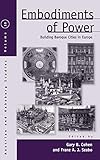Embodiments of Power : Building Baroque Cities in Europe / ed. by Franz A. J. Szabo, Gary B. Cohen.
Material type: TextSeries: Austrian and Habsburg Studies ; 10Publisher: New York ; Oxford : Berghahn Books, [2008]Copyright date: ©2008Description: 1 online resource (320 p.)Content type:
TextSeries: Austrian and Habsburg Studies ; 10Publisher: New York ; Oxford : Berghahn Books, [2008]Copyright date: ©2008Description: 1 online resource (320 p.)Content type: - 9781845454333
- 9780857450500
- Architecture, Baroque -- Austria
- Architecture, Baroque -- Europe
- Cities and towns, Renaissance
- City planning -- Europe -- History
- Power (Social sciences) -- Austria -- History
- Power (Social sciences) -- Europe -- History
- Sociology, Urban -- Austria
- Sociology, Urban -- Europe
- HISTORY / Europe / Austria & Hungary
- History: Medieval/Early Modern, History: 18th/19th Century, Urban Studies
- 303.3094 22
- HT131 .E55 2008eb
- online - DeGruyter
| Item type | Current library | Call number | URL | Status | Notes | Barcode | |
|---|---|---|---|---|---|---|---|
 eBook
eBook
|
Biblioteca "Angelicum" Pont. Univ. S.Tommaso d'Aquino Nuvola online | online - DeGruyter (Browse shelf(Opens below)) | Online access | Not for loan (Accesso limitato) | Accesso per gli utenti autorizzati / Access for authorized users | (dgr)9780857450500 |
Frontmatter -- CONTENTS -- LIST OF ILLUSTRATIONS -- NOTES ON CONTRIBUTORS -- ACKNOWLEDGEMENTS -- INTRODUCTION Embodiments of Power: Building Baroque Cities in Austria and Europe -- Chapter 1 EMBODIMENTS OF POWER? Baroque Architecture in the Former Habsburg Residences of Graz and Innsbruck -- Chapter 2 BAROQUE COMES FOR THE ARCHBISHOPS Wolf Dietrich von Raitenau, Johann Ernst Count Thun, and Their Ideals of “Modern Art” and Architecture -- Chapter 3 RELIGIOUS ART AND THE FORMATION OF A CATHOLIC IDENTITY IN BAROQUE PRAGUE -- Chapter 4 PRAGUE, WROCŁAW, AND VIENNA Center and Periphery in Transformations of Baroque Culture? -- Chapter 5 REPRESENTATION OF THE COURT AND BURGHERS IN THE BAROQUE CITIES OF THE HIGH ROAD Kraków, Wrocław, and Dresden in a Historical Comparison -- Chapter 6 FROM PROTESTANT FORTRESS TO BAROQUE APOTHEOSIS Dresden from the Sixteenth to the Eighteenth Century1 -- Chapter 7 A TALE OF TWO CITIES Nuremberg and Munich -- Chapter 8 SEARCHING FOR THE NEW CONSTANTINE Early Modern Rome as a Spanish Imperial City -- Chapter 9 THE ZODIAC IN THE STREETS Inscribing “Buon Governo” in Baroque Naples -- Chapter 10 A SETTING FOR ROYAL AUTHORITY Th e Reshaping of Madrid, Sixteenth to Eighteenth Centuries -- BIBLIOGRAPHY -- INDEX
restricted access online access with authorization star
http://purl.org/coar/access_right/c_16ec
The period of the baroque (late sixteenth to mid-eighteenth centuries) saw extensive reconfiguration of European cities and their public spaces. Yet, this transformation cannot be limited merely to signifying a style of art, architecture, and decor. Rather, the dynamism, emotionality, and potential for grandeur that were inherent in the baroque style developed in close interaction with the need and desire of post-Reformation Europeans to find visual expression for the new political, confessional, and societal realities. Highly illustrated, this volume examines these complex interrelationships among architecture and art, power, religion, and society from a wide range of viewpoints and localities. From Krakow to Madrid and from Naples to Dresden, cities were reconfigured visually as well as politically and socially. Power, in both its political and architectural guises, had to be negotiated among constituents ranging from monarchs and high churchmen to ordinary citizens. Within this process, both rulers and ruled were transformed: Europe left behind the last vestiges of the medieval and arrived on the threshold of the modern.
Mode of access: Internet via World Wide Web.
In English.
Description based on online resource; title from PDF title page (publisher's Web site, viewed 25. Jun 2024)


